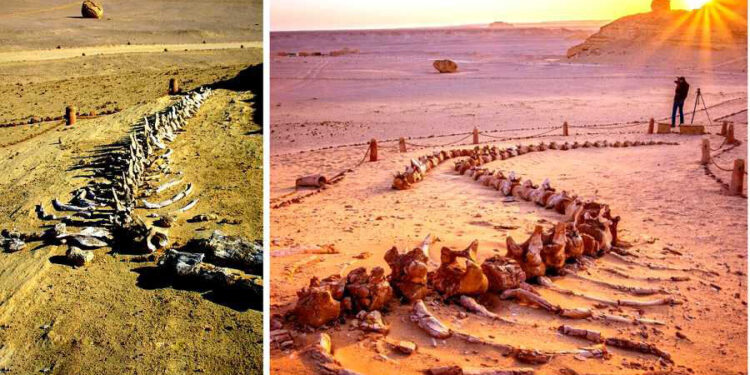Egypt is renowned for its pyramids, Pharaohs, and golden sands that hold treasures from the bygone era. Excavations have uncovered priceless artifacts and entire cities. But beyond the Sphinx and the Valley of Kings lies a historically significant site known as “Wadi El Hitan,” which is situated 160 km southwest of the Pyramids of Giza.
Wadi El Hitan (a.k.a. Valley of Whales), an ancient Egyptian desert, holds the secret of a remarkable transformation in the evolution of life on planet Earth. This desert was once a vast ocean and home to hundreds of fossils, including some of the earliest forms of whales, the archaeoceti (primitive whales). This site is of great importance and was designated a UNESCO World Heritage Site in 2005.

According to Daily News Egypt: “About 37 years ago at the Fayoum desert, where the 200-square-kilometre Wadi Al-Hitan is located, was covered with water as part of the old Mediterranean Sea ‘Tethys Sea’ which existed about 200 million years ago. The Tethys Sea existed over Fayoum almost 200m years ago, before shrinking North and becoming the Mediterranean Sea and desertification turning the sea floor into a desert.”
The number, concentration, and quality of fossils at Wadi El Hitan are unique, providing evidence of millions of years of coastal marine life and evolution. These remains show the transition from land animals to ocean-going mammals, and even some stomach contents have remained intact.

In 1903, the Valley of Whales was first introduced to the world as the site where the first fossil skeletons of whales were discovered. However, for many years, the site was neglected due to its inaccessibility. In the late 1980s, with the advent of all-wheel-drive vehicles, more people started visiting the site and documenting its discoveries. The site soon became a popular destination for scholars, fossil collectors, and tourists.
Unfortunately, many of the fossils were taken from the site without proper documentation or conservation, leading to their eventual disappearance. This prompted calls for better protection and preservation of the site.
One of the most significant finds at the Valley of Whales was the largest fossil, measuring 21 meters in length. The fossil displayed clear evidence of five-fingered flippers on its forelimbs and an unexpected discovery of hind legs, feet, and toes, features previously unknown in “archaeoceti” (primitive whales that document the transition of whales to a marine lifestyle).
The site is considered to be one of the most valuable of its kind due to the concentration, quality, and accessibility of its fossils, all within an attractive and protected landscape.
Wadi El Hitan is a treasure trove of ancient fossils, showcasing an extensive collection of Archaeoceti skeletons and sirenians. The site boasts well-preserved fossils of reptiles and shark teeth that date back 40 million years, including the fossils of crocodiles, sea turtles, and sea snakes.
The largest concentration of fossils at the site are isolated small teeth, though larger fish fossils, such as sawfish rostra, are also present. A standout feature of the site is a 1.8-meter-long sawfish rostrum.
In addition to these fossils, Wadi El Hitan also contains a diverse array of fossilized shells and nummulite fossils. The strata in this area are from the Middle Eocene and contain a vast number of vertebrate fossils within 200 km 2 of the desert. Researchers have discovered many whale fossils, as well as the fossils of sea cows, among over one hundred different fossils cataloged at the site.

Modern whale skeletons reveal remnants of hind leg bones that suggest a terrestrial ancestry, however, these bones serve no purpose in the aquatic environment and are slowly disappearing through the process of natural selection. This leads researchers to speculate that these creatures once roamed the land.
Finding fossil evidence to support this theory can be a challenge, but in the case of whales, science has been fortunate. The discovery of the legs, knees, and feet of extinct whale species provides concrete proof and has reshaped the understanding of their evolutionary history, challenging previously held beliefs about their ancestral lineage. The physical evidence can be unforgiving, leading to a revision of the tree of life.
The Wadi El Hitan is a unique and well-protected site, as not many tourists venture to this area due to its remote location, accessible only through unmarked and unpaved desert roads. Most of the visitors are foreigners who camp in the valley, and the site has been turned into a tourist venue with walkways and small shelters placed among the main fossils.
The Wadi El Hitan is not only rich in fossils, but also home to over 15 species of desert plants and 15 different types of mammals, including the red fox and the Egyptian mongoose. The site is frequently visited by Fennec Foxes, who come searching for food at night. The site is located within the Wadi El Rayan Protected Area.
Wadi Al Hitan, located behind the fiery mountain of Garet Gohannam, attracts only about 1,000 visitors annually who come via four-wheel drive. This is due to the fact that the track is unpaved and crosses unmarked desert sands. Most visitors are foreigners who camp in the valley during winter weekends.
To preserve the area, visitors are limited to prearranged guided tours along a prescribed trail as part of the Wadi El Rayan Protected Area management plan. However, sustainable tourism is growing in the area, with 4WD vehicles being replaced by foot or camel treks.
Since Wadi Al Hitan was turned into a tourist destination, walkways and small shelters have been added for visitors to explore the main fossils. The valley is now frequently visited by tourist groups and has a small campground.
In 2007, a dispute arose when the Egyptian government claimed that Belgian diplomats entered a protected zone and damaged a whale fossil, causing 10 million US dollars worth of damage. The Belgian government denies the allegations and the issue remains unresolved.























